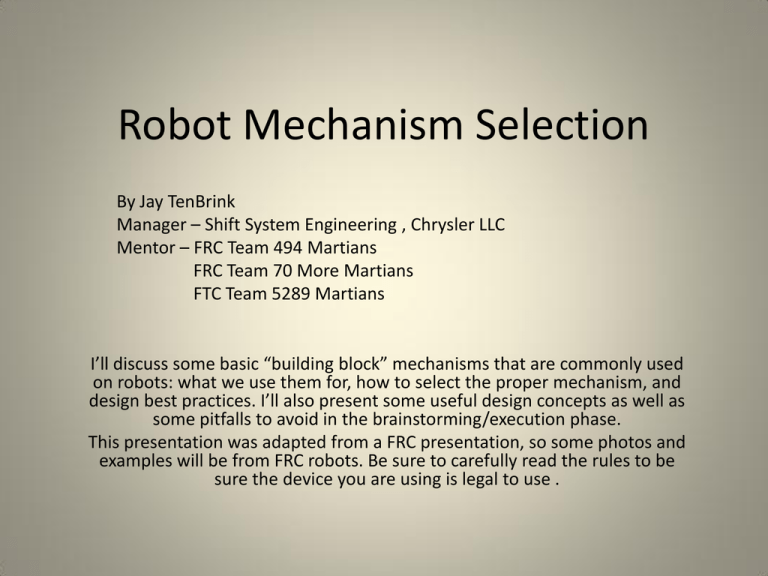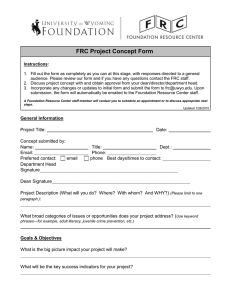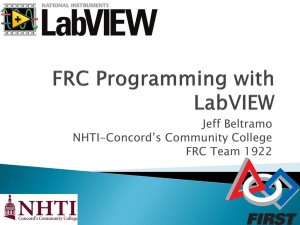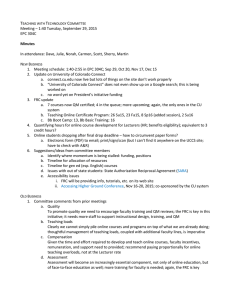Robot Mechanism Selection
advertisement

Robot Mechanism Selection By Jay TenBrink Manager – Shift System Engineering , Chrysler LLC Mentor – FRC Team 494 Martians FRC Team 70 More Martians FTC Team 5289 Martians I’ll discuss some basic “building block” mechanisms that are commonly used on robots: what we use them for, how to select the proper mechanism, and design best practices. I’ll also present some useful design concepts as well as some pitfalls to avoid in the brainstorming/execution phase. This presentation was adapted from a FRC presentation, so some photos and examples will be from FRC robots. Be sure to carefully read the rules to be sure the device you are using is legal to use . Pivoting motion Pivoting motion is the simplest, lightest and most robust type of movement. 1. 2. 3. 4. 5. Simple bolt or pin pivot. Lightweight and low accuracy. Good where low side loads and limited rotational movement are expected. Gap control is important. Friction between moving parts is a concern. Lubricant or Teflon washers/sheet can be used to prevent friction and galling. Bronze or plastic bushings. Lightweight and accurate. Good for higher radial loads and where more rotational movement is expected. Available with or without mounting housing. Usually used in pairs to reduce bending on the joint. Good balance of weight/performance/ease of use. Ball bearings. Heavier than bushings, but very accurate, low friction, and best load carrying capacity. Most often used in pairs to eliminate bending through the bearing, but could be paired with a bushing on the other end of a shaft. Available in plastic. Turntable bearings. Good for planar applications where there is no shaft and where the centerline of the bearing needs to be kept open. Low cost, cast aluminum turntable bearings are available in various sizes from McMaster Carr. Hybrid. Sometimes it makes sense to use two types together where a shaft has high loads only on one end but only needs to be stabilized on the other end. Pivot motion examples Plastic journal bearing Pinned Joint Bronze bushings Simple Pin Pivot Joint Ball Bearing (FRC example) Turntable Bearing (FRC example) Sliding motion Sliding motion is usually used to extend the reach of a positioning arm or where pure linear motion is required. 1. 2. 3. Concentric members with full contact sliding action, or a tube within a tube. This is a simple, lightweight method but not robust against damage and typically has high friction when side loaded. Parallel members with sliding bushings. Better load carrying capability, light weight, and lower friction. Bushings typically are spread as far apart as possible. Bushing material should not extend the full length of the member. Good for stability and moderately robust against damage. Parallel members with bearing guides. Best load carrying capability, good stability, lowest friction, usually the heaviest and most robust against damage, such as bent or nicked parts or foreign material. Many COTS slides are available, but typically are designed for relatively short lengths of travel. Sliding motion Examples Sliding bushings Bearing guides (FRC examples) 4 bar linkages Translational and rotational movement can be achieved with links that have only pivoting movements. These mechanisms are very adaptable, easy to construct, robust, and lightweight. A good example is the trunk hinge design on your car. Before deciding on what type of basic mechanism to build, make sure you understand: 1) What type of motion do you really need? Does it need to be a pure linear motion, or could it be an articulated motion? 2) Will the parts be under load when it is moving, or only under its own weight? 3) What are the risks of damage to the device and can we make the device robust enough to withstand the rigors of robot to robot interaction? There are 4 bar linkage design simulators available on the internet, such as http://www.mekanizmalar.com/fourbar01.html 4 bar linkage examples Lifting and articulating motion on (2002 FRC robot) Lifting and translating motion. Note that platform remains level. 2012 FTC robot Assist springs and one-way brakes. Arms and end effectors should typically be counterbalanced to a neutral state to reduce the load on the drive motors and make position holding much easier on the motors. 1. Surgical tubing is a light weight, robust, tunable, and low cost material that provides counterbalancing spring force in tension. It does not provide any damping and will decrease it’s elasticity with age. See 2012 FTC robot 2. Directional brakes, a self-energizing servo-brake uses rotational motion in one direction to tighten the brake lining onto the drum or pulley. Counter-rotational motion will loosen the lining. This device will not make it any easier to lift a device, but it will make it easier to hold a device up. These devices are simple to build, lightweight, low cost, tunable, and very robust. See 2011 and 2005 FRC robots. Assist Springs and One-Way Brakes Surgical tubing assist 2012 FTC robot High pressure gas assist spring (not allowed in FTC ) 2008 FRC robot shown One way brakes 2010 FRC and 2005 FRC Rechargeable stored energy devices. Some mechanisms need to deliver a large amount of energy in a short period of time to kick, throw, or shoot a game piece. Some 2008 FRC robots kicked a large, heavy ball over an 8 foot high bridge. Most 2010 FRC robots kicked a soccer ball with a stored energy device. The stored energy can be potential energy or kinetic energy. 1. 2. 3. 4. Springs, surgical tubing, torsional springs can be wound up to store the motor’s power in-between kicks. A spinning flywheel or an elevated mass can also be used to store energy. A relatively small motor can be geared down to wind the springs between shoots. Latching and triggering mechanisms used to hold and release this stored energy must be very robust to reduce the chances of unwanted deployments by bumping, etc. These powerful devices may require a more substantial trigger, such as a motor and not simply a Hi-Tec servo. Over-center devices can use the same motor to wind up and trigger a device if a one way ratcheting mechanism or clutch is used. Photo 2010 FRC Safety. Stored energy devices can cause serious damage or personal injury if proper safety precautions are not followed. Always design in a safe way to lock out and de-energize these devices. Stored Energy Device Example Steel tension springs for stored energy as used on 2010 FRC robot FP motor driven device to wind up the springs Latching mechanism for stored energy device (FRC example) Remote location of motors and actuators It is usually desirable to keep motors as low as possible on the robot to maintain a low CG (center of gravity). It is good to keep motors out of harm’s way. One way is to not locate the motors at the extremity of an arm or in an impact zone. Sometimes the package is so tight that it won’t allow you to put a motor where you want to. 1. 2. 3. 4. 5. Rods or tubes can be used to transfer motor torque in a straight line to drive remote gears, levers, sprockets, etc. See photo – 2012 turret motor Aluminum rods can be used to provide push/pull motion to the end of a robot arm to actuate an end effector remotely. Loose cables, Spectra cord, etc. can be used in a straight line in tension to actuate remote devices and spring loaded to return open. A second tension cable pulling the device in the opposite direction could also be used to return a mechanism to its initial position. Guided cables through a flexible conduit, like a bicycle’s brakes, can easily be routed around corners into tight packaging environments. These are light weight, low cost, robust, and very adaptable. Push/pull cables, like a choke cable on your lawn mower, pass through a flexible conduit around corners and provide force and travel in both directions. Remote location of motors and actuators Drive shaft is used to remotely power the robot’s turret from a window regulator motor mounted low on the robot. 2012 FRC robot Crab drive modules are steered by motors mounted over 24” away. 2010 FRC robot Protection from damage Devices which extend outside of the bumper zone or that have a risk of interaction with another robot or field element should be robust enough to prevent damage during interaction with the field or another robot. This can also be used to reduce the risk of entanglement. 1. 2. 3. 4. Soft structures – deform under load and return to their original configuration when the load is removed. Parts made from Lexan or that incorporate a living hinge can bend and come back when the load is removed. The Flexanator was a semi-rigid Lexan structure that could fully collapse and re-bound. See photo 2008 FRC. Hardened devices. Sometimes it is preferable to make the device strong enough to withstand impact loads and abuse. An example is our 2011 Pick-up roller made of PVC with a motor inside of the rigid tube. Clutches, detents, springs, and deformable joints. These devices serve as a mechanical circuit breaker and can usually be designed to return to position after the load is removed. Slip clutches can be tuned to prevent shafts from being overloaded and broken. Your car door hold open device is a detent. See photo 2005 FRC for clutch. Shear pins, “fuses”, and expendable components. These are intended to be the weakest link and should be quick and easy to replace or repair between matches. Damage Protection - FRC examples “Soft “ Lexan structure “Hardened” PVC structure The Flexanator deflected/un-deflected Spring loaded feature Spring loaded drive motor Clutch Triggered devices and triggering mechanisms Some mechanisms need to be stowed to fit inside of the starting envelope, or during the match to stay out of the way. Some of these mechanisms are powered into position with motors, but some can be deployed with a triggering device. 1. 2. 3. 4. 5. Inertial devices that rely on the mass of the device itself to fall into position when the robot moves. These devices can latch into place or rely on their weight to keep them in position during a match. See photo 2004 FRC. Trapped devices that are released by another active device, such as a raised arm. An example is our 2008 FRC robot with spring loaded antenna that was trapped by the ball handling arm and released when the arm was lifted slightly. Actively triggered devices that are spring loaded and restrained by a “grenade pin”. These can be deployed with a Hi-Tech servo when needed. See 2012 FTC Multi-stage, actively triggered devices. Some devices are under very high loads and cannot be triggered directly by a Hi-Tech servo. A servo can serve as a secondary trigger to release the primary trigger that releases the device. End game devices. A stored energy device triggered just prior to the end of a match can deliver its energy and do work even after the robot is powered down. Triggered Devices / Mechanisms 2004 FRC 2012 FTC HiTech Servo trigger 2011 FRC Inertial drop down with latch 2012 FTC Spring loaded actively triggered Multi-stage trigger with HiTech servo and sliding bolt (FRC example) FMEA (Failure Modes and Effects Analysis) When you design a part or system, think of how it may fail. What is the likelihood of experiencing a failure and what are the consequences. 1. What is the likelihood of experiencing a failure? 2. What are the consequences of a failure? Minor loss of function, total incapacitation for the match, major meltdown, etc.? 3. Will it cause other parts and systems to fail in a chain reaction? 4. What can we do to reduce rate of occurrence or severity? Fail-safe devices It may be desirable to have a secondary mechanical feature to reduce the severity of a mechanical failure, like the safety chains on a trailer hitch, or wearing a belt and suspenders. As an example: If a single broken component would allow a major subassembly to fall off of the robot , a secondary retention device should be considered that would restrain the subassembly . Modular Design • Sometimes teams divide into work groups to design/build the different systems on the robot : drive train and frame, end effector, game piece storage, programing, and driver controls. • Pre-planning and modular design can make this more effective. • Modular designs can also make repairs or design changes easier. Modular shooter Assembly Surrogate Robot Base Questions and Answers This presentation is posted on our website: 494themartians.com . Click on “resources” and look for “FTC Robot Mechanisms” Thank you and good luck



